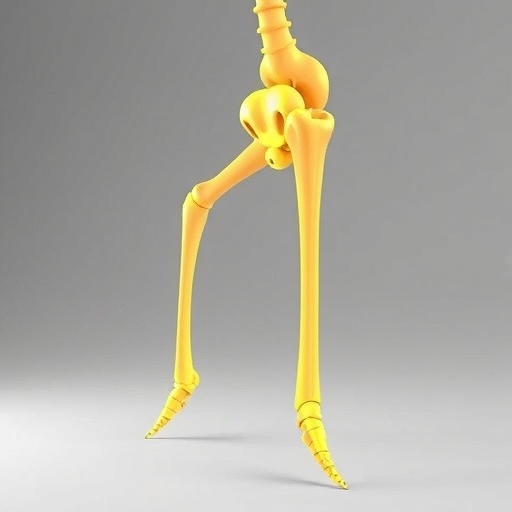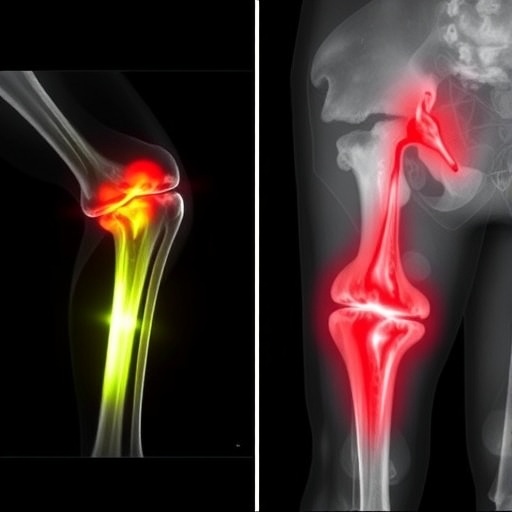The quest for innovative solutions in orthopedic implants has taken an exciting turn with the emergence of advanced manufacturing techniques and innovative structural designs. Researchers at the forefront of this field have introduced a compelling new concept: a bidirectional gradient gyroid structure tailored for tibial stems. This revolutionary design integrates complex geometric patterns with the capabilities of additive manufacturing that allows for enhanced mechanical performance and biocompatibility, potentially changing the landscape of orthopedic treatments.
In conventional tibial stem design, the emphasis has largely been on achieving a balance between strength and weight. Traditional materials and manufacturing methods often fall short of providing optimized structures that can withstand the dynamic loads experienced by the human body. The introduction of gradient gyroid structures is set to challenge these conventional limitations. Gyroids are triply periodic minimal surfaces, providing a unique combination of stiffness and flexibility that could dramatically improve the performance of tibial stems used in joint replacement surgeries.
The design process for the bidirectional gradient gyroid structure capitalizes on this unique geometric capability. By adjusting the porosity and lattice configurations, researchers can create structures that mimic the natural properties of bone, promoting osseointegration—the biological process through which the bone anchors itself to the implant. This essential feature is particularly important for longer-lasting implants, as successful osseointegration minimizes the risk of implant loosening and complications that may arise post-surgery.
Additive manufacturing, often referred to as 3D printing, plays a pivotal role in realizing these complex designs. The layer-by-layer construction process not only allows for intricate geometries that traditional subtractive manufacturing methods cannot achieve but also enables fine-tuning of material properties at a microstructural level. Such precision is crucial for ensuring that the mechanical properties of the implant align with the varying stress distributions it will encounter in real-world applications.
The implementation of gradient porosity in the gyroid structure offers numerous advantages, particularly in terms of tailoring the mechanical properties of the implant. By creating a gradient of porosity—from dense regions to more open structures—manufacturers can design implants that provide strength where it is needed most while reducing weight and material use in less critical areas. This targeted approach could result in lighter implants that maintain structural integrity, improving patient comfort and increasing mobility post-surgery.
Moreover, the potential for customization in patient-specific applications cannot be overstated. With advancements in imaging techniques, surgeons can capture unique anatomical details of individual patients, allowing for designs that are personalized to fit the specific needs and conditions of each patient. This degree of customization enhances surgical outcomes, as implants can be designed to align perfectly with the patient’s biology, enhancing both functionality and aesthetics.
The development of this bidirectional gradient gyroid structure for tibial stems is not merely an academic exercise; it promises to revolutionize orthopedic implants fundamentally. In a field where the success of implants can significantly affect the quality of life for millions of patients, the importance of innovative designs cannot be overstated. The integration of these designs into clinical practice may lead to a paradigm shift in how orthopedic surgeries are approached, offering the promise of better healing, reduced recovery times, and enhanced overall patient satisfaction.
As with any technological advancement, the journey from conceptual design to clinical application is fraught with challenges. Researchers must navigate regulatory pathways, perform extensive testing, and gather clinical evidence to validate the efficacy and safety of these new structures. However, the potential benefits are undeniable, and the enthusiasm surrounding the development of the bidirectional gradient gyroid structure continues to grow among researchers and clinicians alike.
The future of orthopedic implants stands at the intersection of innovation and practicality. With ongoing research and collaboration between engineering and medical professionals, the next generation of implants could redefine what is possible, making significant strides toward improving patient outcomes. As excitement builds around the potential of structures such as the bidirectional gradient gyroid, it is clear that the future of orthopedic surgery is bright and full of promise.
In summary, the conceptual design and additive manufacturing of the bidirectional gradient gyroid structure for tibial stems represent a significant leap forward in orthopedic implant technology. This innovative structure has the potential to change the course of treatment for countless patients, combining strength, flexibility, and personalization in a way that traditional designs have struggled to achieve. As research progresses and these concepts move closer to clinical implementation, the orthopedic community eagerly anticipates the transformative impact of these advancements on patient care and surgical outcomes.
With ongoing exploration and development in this promising field, the convergence of engineering and biomedical sciences holds the key to unlocking new possibilities in orthopedic surgery. As researchers continue to refine their approaches and develop even more sophisticated structures, the horizon looks increasingly optimistic for both patients and healthcare providers alike.
This pioneering work is just the beginning of a bright future for orthopedic implants and the patients who rely on them, making significant contributions to the ever-evolving landscape of medical science and technology.
Subject of Research: Bidirectional Gradient Gyroid Structure for Tibial Stem
Article Title: Conceptual Design and Additive Manufacturing of a Bidirectional Gradient Gyroid Structure for Tibial Stem
Article References:
Taheri, A., Farahmand, F. & Bahraminasab, M. Conceptual Design and Additive Manufacturing of a Bidirectional Gradient Gyroid Structure for Tibial Stem.
Ann Biomed Eng (2025). https://doi.org/10.1007/s10439-025-03854-4
Image Credits: AI Generated
DOI: 10.1007/s10439-025-03854-4
Keywords: Tibial Stem, Gradient Gyroid, Additive Manufacturing, Orthopedic Implants, Biocompatibility, Osseointegration, Customization, Mechanical Properties
Tags: additive manufacturing in orthopedicsadvantages of gyroid structuresbidirectional gradient gyroidbiocompatibility in orthopedic implantscomplex geometric patterns in implantsfuture of joint replacement technologymechanical performance of tibial stemsoptimizing tibial stem strength and weightorthopedic implant advancementsorthopedic treatments revolutionosseointegration in joint replacementstibial stem design innovations





